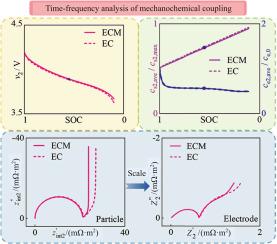A joint time-frequency analysis of the mechanical-electrochemical coupling mechanism from particles to electrodes for the Li-ion battery
IF 16.4
引用次数: 0
Abstract
Diffusion-induced stress (DIS) originates from the shrinkage/expand during Li extraction/insertion from/into the active particle for the Li-ion battery (LIB). Till today, the two-way coupled mechanical-electrochemical mechanism is still unclear. The above challenge can be decomposed into 2W + lH as follows: (i) Why need to reveal the two-way coupled mechanical-electrochemical mechanism? (ii) What is the two-way coupled mechanical-electrochemical mechanism? (iii) How to reveal the two-way coupled mechanical-electrochemical mechanism. In the process of answering the above 2W + lH, the following contributions have been made in this work: (i) An electro-chemo-mechanical (ECM) model is established for the LIB, in which the mechanical-electrochemical coupling is two-way; (ii) The mechanical-electrochemical responses are solved for the ECM model in the time/frequency domain, respectively; (iii) The time-domain analysis shows that DIS enhances Li diffusion at the early and middle stages of discharge, while DIS inhibits Li diffusion at the end of discharge; (iv) The frequency-domain analysis shows that stress mainly affects solid-phase diffusion instead of electrolyte-phase diffusion. In a word, the multi-scale analysis quantitatively analyzes the impact of DIS on Li diffusion on the particle scale and reveals the two-way coupled mechanical-electrochemical mechanism on the electrode scale. The above results provide theoretical support for the battery manufacture and stress monitoring.

锂离子电池从颗粒到电极的机械-电化学耦合机制时频联合分析
扩散诱发应力(diffusion induced stress, DIS)是锂离子电池(LIB)活性粒子在锂离子离子萃取/插入/进入过程中的收缩/膨胀引起的。到目前为止,机械-电化学的双向耦合机理仍不清楚。上述挑战可以分解为2W + lH: (i)为什么需要揭示双向耦合的机械-电化学机理?(ii)什么是双向耦合的机械-电化学机制?(三)如何揭示双向耦合的机械-电化学机理。在回答上述2W + lH问题的过程中,本工作做出了以下贡献:(i)建立了LIB的电化学-机械(ECM)模型,其中机械-电化学耦合是双向的;(ii)分别在时域和频域中求解ECM模型的力学-电化学响应;(iii)时域分析表明,DIS在放电前期和中期增强了锂离子的扩散,而在放电后期抑制了锂离子的扩散;(iv)频域分析表明,应力主要影响固相扩散而非电解相扩散。总之,多尺度分析定量分析了DIS在颗粒尺度上对Li扩散的影响,揭示了电极尺度上双向耦合的机械-电化学机理。上述结果为电池制造和应力监测提供了理论支持。
本文章由计算机程序翻译,如有差异,请以英文原文为准。
求助全文
约1分钟内获得全文
求助全文

 求助内容:
求助内容: 应助结果提醒方式:
应助结果提醒方式:


